
Ahuitzotl was the eighth Aztec ruler, the Huey Tlatoani of the city of Tenochtitlan, son of princess Atotoztli II. His name literally means "Water Thorny" and was also applied to the otter. It is also theorized that more likely, the animal called ahuitzotl is actually the water opossum, the hand symbolizing its prehensile tail, which otters notably lack.

Moctezuma Xocoyotzin, variant spellings include Motewksomah, Motecuhzomatzin, Montezuma, Moteuczoma, Motecuhzoma, Motēuczōmah, Muteczuma, and referred to retroactively in European sources as Moctezuma II, was the ninth Emperor of the Aztec Empire, reigning from 1502 or 1503 to 1520. Through his marriage with queen Tlapalizquixochtzin of Ecatepec, one of his two wives, he was also king consort of that altepetl.

Tenochtitlan, also known as Mexico-Tenochtitlan, was a large Mexican altepetl in what is now the historic center of Mexico City. The exact date of the founding of the city is unclear. The date 13 March 1325 was chosen in 1925 to celebrate the 600th anniversary of the city. The city was built on an island in what was then Lake Texcoco in the Valley of Mexico. The city was the capital of the expanding Aztec Empire in the 15th century until it was captured by the Spanish in 1521.

The Aztecs were a Mesoamerican culture that flourished in central Mexico in the post-classic period from 1300 to 1521. The Aztec people included different ethnic groups of central Mexico, particularly those groups who spoke the Nahuatl language and who dominated large parts of Mesoamerica from the 14th to the 16th centuries. Aztec culture was organized into city-states (altepetl), some of which joined to form alliances, political confederations, or empires. The Aztec Empire was a confederation of three city-states established in 1427: Tenochtitlan, city-state of the Mexica or Tenochca; Texcoco; and Tlacopan, previously part of the Tepanec empire, whose dominant power was Azcapotzalco. Although the term Aztecs is often narrowly restricted to the Mexica of Tenochtitlan, it is also broadly used to refer to Nahua polities or peoples of central Mexico in the prehispanic era, as well as the Spanish colonial era (1521–1821). The definitions of Aztec and Aztecs have long been the topic of scholarly discussion ever since German scientist Alexander von Humboldt established its common usage in the early 19th century.
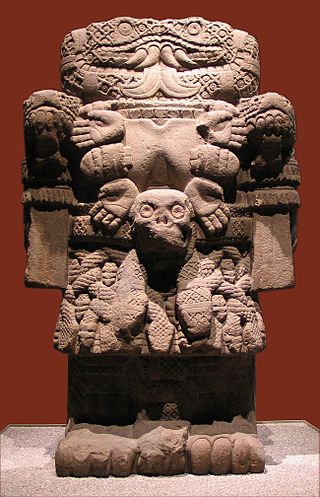
Coatlicue, wife of Mixcōhuātl, also known as Tēteoh īnnān is the Aztec goddess who gave birth to the moon, stars, and Huītzilōpōchtli, the god of the sun and war. The goddesses Toci "our grandmother" and Cihuacōātl "snake woman", the patron of women who die in childbirth, were also seen as aspects of Cōātlīcue.
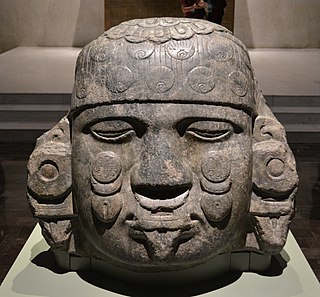
In Aztec religion, Coyolxāuhqui is a daughter of the priestess Cōātlīcue. She was the leader of her brothers, the Centzon Huitznahua. She led her brothers in an attack against their mother, Cōātlīcue, when they learned she was pregnant, convinced she dishonored them all. The attack is thwarted by Coyolxāuhqui's other brother, Huitzilopochtli, the national deity of the Mexicas.

In Aztec mythology, Cihuacōātl[siwaˈkoːaːt͡ɬ] was one of a number of motherhood and fertility goddesses. Cihuacōātl was sometimes known as Quilaztli.

Tlaltecuhtli is a pre-Columbian Mesoamerican deity worshipped primarily by the Mexica (Aztec) people. Sometimes referred to as the "earth monster," Tlaltecuhtli's dismembered body was the basis for the world in the Aztec creation story of the fifth and final cosmos. In carvings, Tlaltecuhtli is often depicted as an anthropomorphic being with splayed arms and legs. Considered the source of all living things, he had to be kept sated by human sacrifices which would ensure the continued order of the world.

In Aztec mythology, Xipe Totec or Xipetotec was a life-death-rebirth deity, god of agriculture, vegetation, the east, spring, goldsmiths, silversmiths, liberation, and the seasons. The female equivalent of Xipe Totec was the goddess Xilonen-Chicomecoatl.
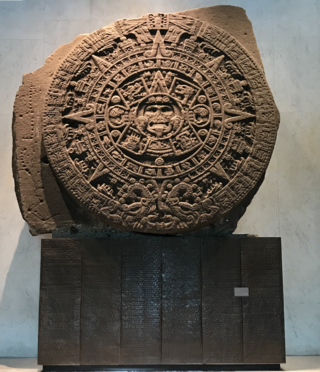
The Aztec or Mexica calendar is the calendrical system used by the Aztecs as well as other Pre-Columbian peoples of central Mexico. It is one of the Mesoamerican calendars, sharing the basic structure of calendars from throughout ancient Mesoamerica.

The Templo Mayor was the main temple of the Mexica people in their capital city of Tenochtitlan, which is now Mexico City. Its architectural style belongs to the late Postclassic period of Mesoamerica. The temple was called Huēyi Teōcalli[we:ˈi teoːˈkali] in the Nahuatl language. It was dedicated simultaneously to Huitzilopochtli, god of war, and Tlaloc, god of rain and agriculture, each of which had a shrine at the top of the pyramid with separate staircases. The central spire was devoted to Quetzalcoatl in his form as the wind god, Ehecatl. The Great Temple devoted to Huitzilopochtli and Tlaloc, measuring approximately 100 by 80 m at its base, dominated the Sacred Precinct. Construction of the first temple began sometime after 1325, and it was rebuilt six times. The temple was destroyed by the Spanish in 1521, and the Mexico City cathedral was built in its place.

The Aztec Empire or the Triple Alliance was an alliance of three Nahua city-states: Mexico-Tenochtitlan, Tetzcoco, and Tlacopan. These three city-states ruled that area in and around the Valley of Mexico from 1428 until the combined forces of the Spanish conquistadores and their native allies who ruled under Hernán Cortés defeated them in 1521.

Eagle warriors or eagle knights were a special class of infantry soldier in the Aztec army, one of the two leading military special forces orders in Aztec society, the other being the Jaguar warriors. They were a type of Aztec warrior called a cuāuhocēlōtl[kʷaːwoˈseːloːt͡ɬ]. The word cuāuhocēlōtl derives from the eagle warrior cuāuhtli and the jaguar warrior ocēlōtl[oˈseːloːt͡ɬ]. These military orders were made up of the bravest soldiers of noble birth and those who had taken the greatest number of prisoners in battle. Of all of the Aztec warriors, they were the most feared. Eagle warriors, along with the jaguar warriors, were the only such classes which did not restrict access solely to the nobility, as commoners or, in Nahuatl, "mācēhualli" Nahuatl pronunciation: [maːseːwalːi] were occasionally admitted for special merit.

The Aztec sun stone is a late post-classic Mexica sculpture housed in the National Anthropology Museum in Mexico City, and is perhaps the most famous work of Mexica sculpture. It measures 3.6 metres (12 ft) in diameter and 98 centimetres (39 in) thick, and weighs 24,590 kg (54,210 lb). Shortly after the Spanish conquest, the monolithic sculpture was buried in the Zócalo, the main square of Mexico City. It was rediscovered on 17 December 1790 during repairs on the Mexico City Cathedral. Following its rediscovery, the sun stone was mounted on an exterior wall of the cathedral, where it remained until 1885. Early scholars initially thought that the stone was carved in the 1470s, though modern research suggests that it was carved some time between 1502 and 1521.
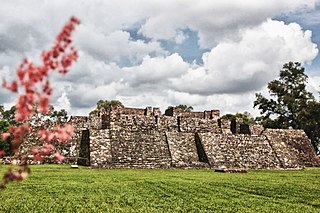
The Aztecs were a Pre-Columbian Mesoamerican people of central Mexico in the 14th, 15th, and 16th centuries. They called themselves Mēxihcah.

The Stone of Motecuhzoma I is a pre-Columbian stone monolith dating back to the rule of Motecuhzoma I (1440-1469), the fifth Tlatoani (ruler) of Tenochtitlan. The monolith measures approximately 12 feet in diameter and 39 inches tall, and is also known as the Stone of Motecuhzoma Ilhuicamina, the Cuauhxicalli of Motecuhzoma Ilhuicamina, the Archbishop's Stone, the Ex-Arzobispado Stone, and the Sánchez-Nava Monolith. Historical sources refer to it simply as "temalacatl," literally meaning "round stone."

The Stone of Tizoc, Tizoc Stone or Sacrificial Stone is a large, round, carved Aztec stone. Because of a shallow, round depression carved in the center of the top surface, it may have been a cuauhxicalli or possibly a temalacatl. Richard Townsend maintains, however, that the depression was made in the 16th century for unknown purposes.
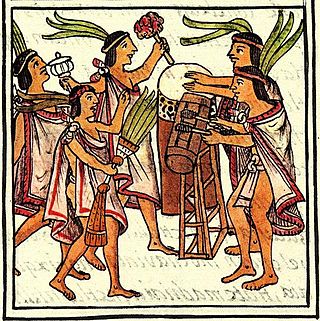
The Mexica were a Nahuatl-speaking indigenous people of the Valley of Mexico who were the rulers of the Aztec Empire. The Mexica established Tenochtitlan, a settlement on an island in Lake Texcoco, in 1325. A dissident group in Tenochtitlan separated and founded the settlement of Tlatelolco with its own dynastic lineage. In 1521, they were conquered by an alliance of Spanish conquistadors and indigenous people including the Tlaxcaltecs led by Hernán Cortés.

The Coatlicue statue is one of the most famous surviving Aztec sculptures. It is a 2.52 metre (8.3 ft) tall andesite statue by an unidentified Mexica artist. Although there are debates about what or who the statue represents, it is usually identified as the Aztec deity Coatlicue ("Snakes-Her-Skirt"). It is currently located in the National Museum of Anthropology in Mexico City. Originally displayed in the Mexica city of Tenochtitlan, the momentous statue was buried after the 1521 Spanish conquest of the city and excavated roughly 270 years later in 1790.

The Coyolxāuhqui Stone is a carved, circular Aztec stone, depicting the mythical being Coyolxāuhqui ("Bells-Her-Cheeks"), in a state of dismemberment and decapitation by her brother, the patron deity of the Aztecs, Huitzilopochtli. It was rediscovered in 1978 at the site of the Templo Mayor of Tenochtitlan, now in Mexico City. This relief is one of the best known Aztec monuments and one of the few great Aztec monuments that have been found fully in situ.




















